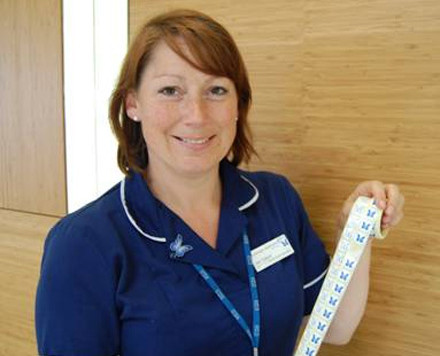New dementia awareness scheme launched
A new initiative aimed at helping raise awareness of patients with dementia in hospital has been launched at St George’s University Hospitals NHS Foundation Trust.
The Butterfly Scheme works by identifying patients with dementia that require extra support from healthcare staff. A sticker with a picture of a blue butterfly is affixed to the notes and name boards of patients with dementia. This makes staff aware of the patient’s needs and allows the appropriate level of care to be given.
Staff who have learnt more about the scheme also wear a blue butterfly badge to identify themselves to colleagues, patients and their families should information or advice be required.
Jen Tulloch, clinical nurse specialist for dementia said: “The Butterfly Scheme enables staff to offer the most suitable care to patients with dementia. Everyone who meets a patient has an effect on their safety, and through this scheme staff will be able to offer considerate and suitable support to patients with memory impairment.”
“The scheme is recommended by staff at other hospitals that have used it for some time, which indicates that it is an extremely useful tool in patient care.”
Notes to editors
For more information, please contact the Communications Unit on 020 8725 5151 or email communications@stgeorges.nhs.uk. Outside working hours, please page us by calling 0844 822 2888, leaving a short message and contact details for pager SG548.
About St George’s Healthcare NHS Trust
- St George’s University Hospitals NHS Foundation Trust is one of the largest healthcare providers in southwest London. Its main site, St George’s Hospital in Tooting – one of the country’s principal teaching hospitals – is shared with St George’s, University of London, which trains medical students and carries out advanced medical research. As well as acute hospital services, the trust provides a wide variety of specialist and community hospital based care and a full range of community services to children, adults, older people and people with learning disabilities. These services are provided from Queen Mary’s Hospital, Roehampton, 11 health centres and clinics, schools and nurseries, patients’ homes and Wandsworth Prison.
- St George’s Hospital, Tooting, is one of London’s four major trauma centres. In 2011/12 the emergency department at St George’s Hospital treated an average 447 patients each day, with 95.06 per cent of patients being admitted, transferred or discharged within four hours.
- St George’s Hospital is one of eight hyper acute stroke units in London. The trust’s stroke services were rated as the best in the country by the National Sentinel Audit 2010, and in the top four in 2011.
- St George’s Hospital has one of the biggest and busiest of the eight heart attack centres in London. The heart attack centre at St George’s Hospital was rated as having the best response rate for treating heart attack patients in London in the 2012 Myocardial Ischaemia National Audit Project (MINAP).
- The trust is an accredited centre of excellence for trauma, neurology, cardiology and cancer services, and the national centre for family HIV care and bone marrow transplantation for non-cancer diseases.
- In 2011 the trust was named by the Dr Foster report for the Department of Health in the group of trusts with the lowest mortality rates in the country. The trust was one of only 14 in the country to have statistically significant lower than expected mortality rates.
- The trust passed all national cancer treatment and diagnosis targets in 2011/12, improving the prospects for thousands of cancer patients.
- In April 2012 the trust reported its lowest ever infection rates, with a 95 per cent reduction in MRSA over the last five years and only one MRSA bacteraemia (blood stream) infection in 2011/12.
- The 2011 Care Quality Commission (CQC) national inpatient survey has confirmed that the trust is achieving results expected of a major healthcare provider, ranking ‘about the same’ as similar trusts in the country in all 77 survey questions.
- The trust has returned a financial surplus for the last five years and has no historic debt. This has allowed the trust to invest in front line services and estate and facilities development, including the recent redevelopment of the A&E unit, the opening of a state-of-the-art regional breast cancer screening centre, and the development of a new pre-operative care centre. The trust is also developing state-of-the-art neurorehabilitation services at St George’s and Queen Mary’s Hospitals.


